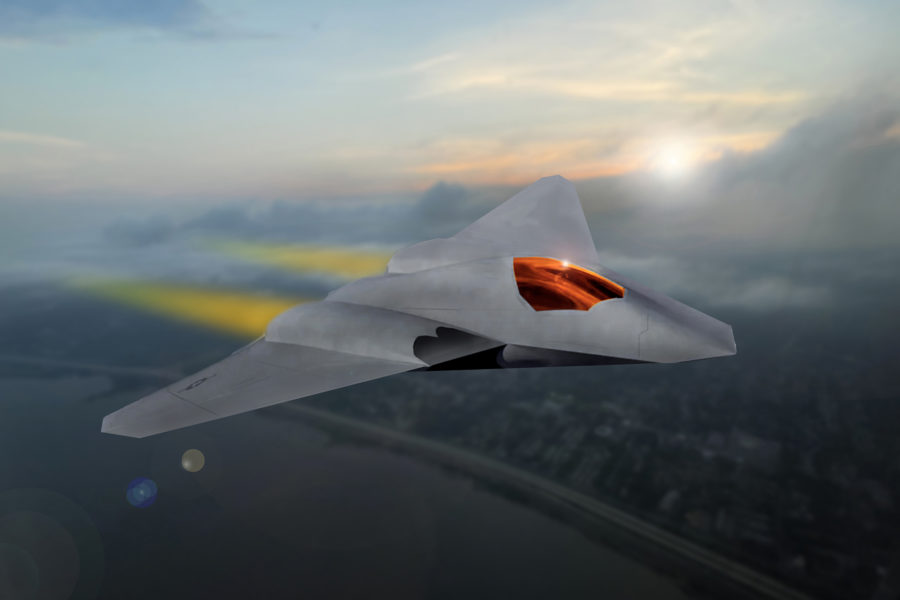The Air Force has requested $1.3 billion over the next three years to compete development of a new engine to power the Next-Generation Air Dominance fighter, which will succeed the F-22. The effort, already well underway, picks up where the Adaptive Engine Transition Program left off, and may yield a new powerplant ready for production in the 2028 time period.
The funding is included in one of five advanced propulsion development accounts in the Air Force’s fiscal 2025 research, development, test, and evaluation budget request—collectively worth more than $4 billion through 2029—which also fund development of new propulsion technologies pertaining to materials, fuels, rockets, and hypersonic systems.
According to budget documents for the “Advanced Engine Development” program element, the Next-Generation Adaptive Propulsion (NGAP) program will “design and perform risk reduction” for adaptive engine prototypes applicable to NGAD, the secretive fighter set to enter flight test around 2028.
“NGAP will select appropriate adaptive engine technologies that can meet [NGAD]…engine requirements while ensuring appropriate manufacturing and technology readiness levels,” according to the documents. These technology maturation and risk reduction activities will ensure that once the design is set, production and testing can start with little delay.
The Air Force said the NGAP effort “consists of six phases: initial design, preliminary design, adaptive prototyping planning, detailed design, engine fabrication, and engine assessments.” Initial and preliminary design activities are already complete, indicating that prototypes are now being sketched out.
The Air Force has said that it needs the NGAD to be ready for operational service around 2030, which means its engine, the NGAP, will have to be ready for flight testing at least two years prior.
The plan for fiscal 2025 is to “complete NGAP detailed design activities and transition to prototype engine fabrication and assembly activities,” according to budget docs.
Funding dipped from $595.4 million in 2024 to $562.4 million in 2025 “due to transition from prototype planning and detailed design activities to prototype engine fabrication and assembly,” the documents note.
Proposed spending declines again in 2026 to $439.9 million, then again 2027 to $287.5 million. After that, the development account drops to zero, indicating a transition to production.
Funding for the AETP engine was zeroed out for fiscal ’25, and the Air Force said any remaining monies were shifted to NGAP.
The AETP—in the form of GE Aerospace’s XA100 and Pratt & Whitney’s XA101—was designed to fit in the F-35 and would have given that fighter impressive gains in thrust, acceleration, and range. But the Pentagon and the international F-35 partners opted against pursuing it because it could only be applied to the F-35B and C variants with extensive further engineering. Buying the engine only for the Air Force and other countries using the F-35A model would have required creating separate parts, logistics, and maintenance systems, raising costs.
Pratt & Whitney is instead developing the Engine Core Upgrade on the F-35 engine, which it makes.
Last year, Air Force Secretary Frank Kendall said the termination of the F-35 AETP engine was his greatest budgetary regret; one that he wished he had “another shot at.”
Although little is known about the NGAD, Kendall and John Sneden, head of the Life Cycle Management directorate for propulsion, have said the NGAD engine will be smaller than the AETP engines developed by GE and Pratt, arresting a steady growth in engine fan diameter since the 1970s. But it also means the AETP cannot simply be tweaked to power the NGAD. Instead, a wholly new design is required.
Explaining the acquisition strategy for the NGAP, Air Force budget documents note that the service “awarded two limited source, cost-plus incentive fee contracts in FY 2016 to General Electric and Pratt & Whitney due to their unique qualifications to design a high performance, flight-weight adaptive turbine engine in the thrust class for the Adaptive Cycle Engine Transition Program (AETP).”
Embedded in those AETP contracts “was an option for the Next-Generation Adaptive Propulsion (NGAP) effort through preliminary design. In FY 2018, these options were exercised and awarded to optimize risk reduction.”
In the fourth quarter of fiscal 2022, “new indefinite delivery, indefinite quantity (IDIQ) contracts for completion of NGAP detailed design and prototyping” were awarded to Boeing, General Electric, Lockheed Martin, Northrop Grumman, and RTX’s Pratt & Whitney. Those contracts were worth up to $975 million each over ten years. Those values—measured against the budget profile—suggest much of the funding will come in the procurement phase of the program.
In February, Pratt said it had completed the critical design review on its NGAP engine, which it said bears the designation XA103. GE Aerospace’s engine is the XA102.
The inclusion of Boeing, Lockheed, and Northrop among the NGAP contractors raised eyebrows, as those companies traditionally make airframes and not the engines that power them. However, Air Force officials have said their contribution will be in the form of new propulsive technologies and to refine the integration of the NGAD airframe with its engines.
The Air Force’s acquisition strategy said the contracts “include digital transformation requirements, scope to complete prototype detail design and execute prototype engine testing, digital Weapon System integration activity to reduce technology transition risk, and a contracting approach that enhances the program’s acquisition agility.”
In addition to detailed digital models of the proposed engines, “deliverables” on the existing contracts include “engine hardware (plus spare parts); matured technologies; major rig assessment data (controls, combustor, etc.); program reviews; and technology, affordability and sustainability studies.” Further details can only be provided “in the appropriate forum,” meaning that they are classified.
The NGAD is expected to be a very expensive platform. Kendall has said the aircraft will cost “in the multiple hundreds of millions” of dollars each.
